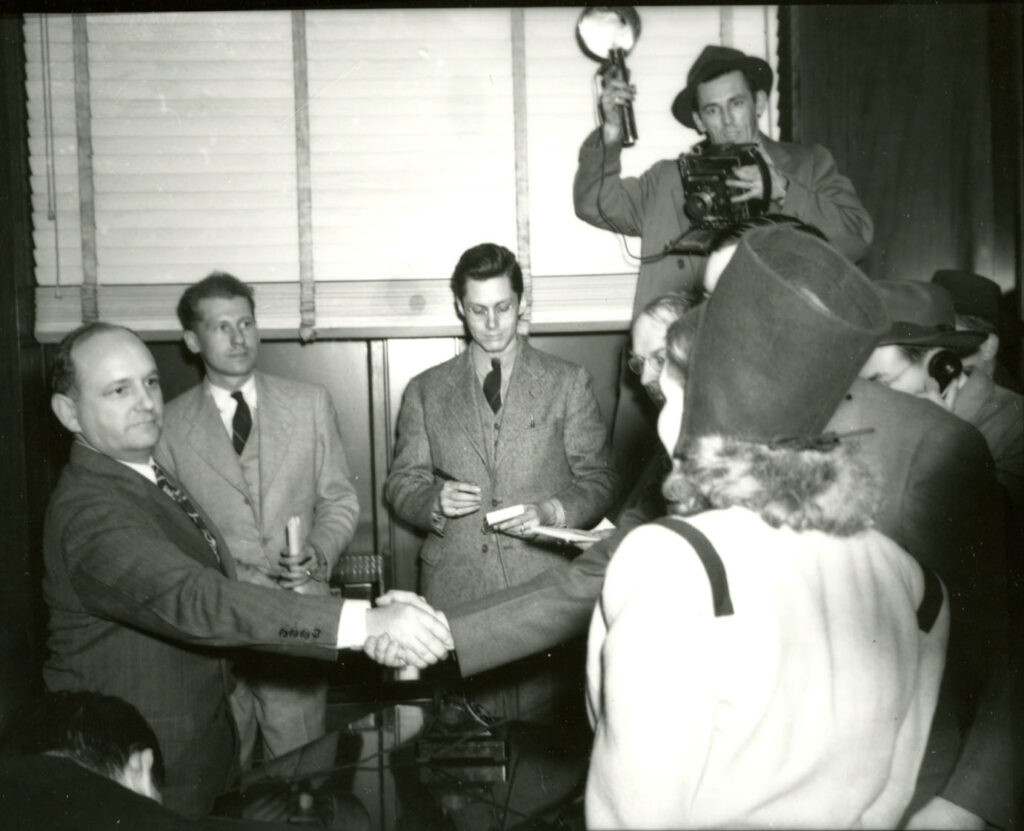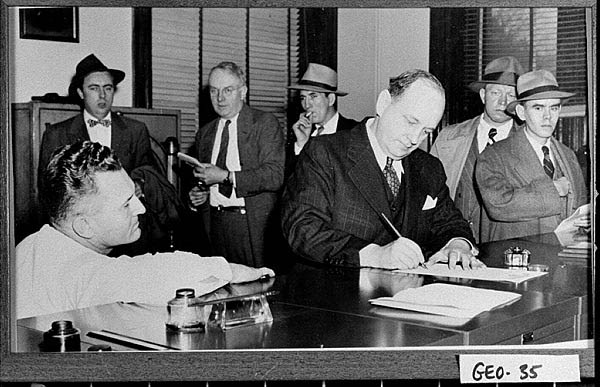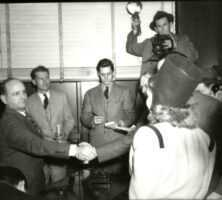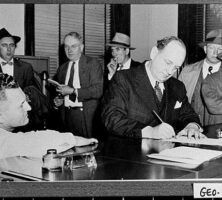Ellis Arnall’s four years as governor of Georgia (1943-47) are considered to be among the most progressive and effective in the modern history of the state. Arnall undertook an ambitious ten-point reform program that was approved by the legislature within twenty-four days of his assuming the governorship—a record still unequalled in Georgia. He accomplished these and other democratic reforms and, in the process, paid off a state debt of $36 million.
Family and Political Career
Ellis Gibbs Arnall was born on March 20, 1907, in Newnan, the son of Bessie Lena Ellis and Joseph Gibbs Arnall. He had one brother, Frank Marion II. After attending public school in Newnan, Arnall attended Mercer University and later transferred to the University of the South, in Sewanee, Tennessee, from which he graduated in 1928 with a degree in Greek. After graduating, Arnall entered the law school at the University of Georgia, where he served as president of his class, his legal fraternity, the student body, the Interfraternity Council, and the Gridiron Club. He finished law school in 1931 and returned to Newnan to practice law. In 1935 he married Mildred Delaney Slemons, and they had two children, Alvan and Alice. Following the death of Mildred in 1980, Arnall married Ruby Hamilton McCord.
Arnall’s rise to political power is one of the most remarkable chapters in the state’s political history. In 1932 voters in his home county of Coweta elected him to the Georgia House of Representatives when he was only twenty-five years old. The members of the lower house twice elected him to the position of Speaker pro tempore, that body’s second-highest elective office. Governor E. D. Rivers appointed Arnall to fill a vacancy in the office of state attorney general and, two years later, named him attorney general; Arnall was thirty-one years old. This appointment made him the nation’s youngest attorney general.

Courtesy of Richard B. Russell Library for Political Research and Studies, University of Georgia Libraries.
In 1942 Arnall ran against Governor Eugene Talmadge, who was seeking reelection. Talmadge’s interference in the running of the state’s university system, in what became known as the Cocking affair, had resulted in the loss of accreditation of most of the state’s public colleges. On this issue, the thirty-five-year-old Arnall defeated Talmadge to become the youngest governor in the nation.
Gubernatorial Accomplishments
Arnall provided four years of progressive reform, replacing the state’s “Tobacco Road” national image with that of a progressive and forward-looking state. He successfully led efforts to restore accreditation to Georgia’s institutions of higher learning. He reformed the state penal system, repealed the poll tax, lowered the voting age, revised the state constitution, established a teachers’ retirement system, and paid off the long-existing state debt. Promising to end gubernatorial dictatorship in the state, Arnall led efforts to create eight constitutional boards in an effort to reduce the power of the governor. He also created a merit system for state employees and the State Ports Authority. Arnall successfully led the South’s fight against discriminatory railroad freight rates, which had hampered the region’s industrial development. As a result of his reform program, members of the national press found themselves in the unusual position of praising rather than condemning a governor of Georgia.
Just as remarkable as Arnall’s political ascendancy was his political decline. The state constitution prohibited gubernatorial succession, and Arnall suffered his first major defeat when he failed to persuade the legislature to propose a constitutional amendment allowing gubernatorial succession. Arnall also lost popularity by leading the efforts at the 1944 National Democratic Convention to renominate Vice President Henry A. Wallace. The liberal Wallace was unpopular in Georgia. But most damaging to Arnall’s political career was his stance on allowing Blacks to vote in the state’s white primaries. A federal district court held that the state’s white primaries were unconstitutional. Arnall refused to follow the examples of other southern states, which tried to evade the court’s mandate. His inaction allowed the Eugene Talmadge faction to denounce him as a traitor to the white race. Many white Georgians believed Arnall was too liberal on the race issue, and a politically revived Talmadge won the 1946 primary by promising to restore the state’s white primary. Many also resented Arnall’s best-selling books, The Shore Dimly Seen (1946) and What the People Want (1948), and his nationwide lecture tour that, they believed, belittled the South.

Courtesy of Georgia Archives.
The end of Arnall’s tenure as governor proved to be as memorable as anything he actually achieved in office because of the “three governors controversy,” a dispute over the rightful heir to the governorship that erupted in the wake of Talmadge’s death one month after winning the election. With both the lieutenant governor Melvin E. Thompson and Talmadge’s son, Herman, vying for the post-election vacancy, Arnall made it a three-way contest by refusing to vacate the governor’s office until the dispute was settled. He dropped his claim to the office two months before the matter was resolved by the state supreme court, which ruled that Thompson would serve as acting governor until a special election could be held the following year.
Later Career
After leaving the governorship in 1947, Arnall became a successful attorney and businessman in Atlanta. For a brief period he served in the administration of U.S president Harry S. Truman as director of the office of price stabilization. Truman offered him the position of U.S. solicitor general, but he declined. Arnall again ran for governor in 1966. He was the front-runner in the Democratic primary in a field of six candidates, but he was forced into a runoff with Lester Maddox, a well-known segregationist. Maddox defeated Arnall in the runoff. The former governor never sought public office again.
Ellis Arnall died in 1992 at the age of eighty-five. In 2011 a historical marker honoring him was dedicated in Newnan.







